Masayuki Suzuki
Granite-speech: open-source speech-aware LLMs with strong English ASR capabilities
May 14, 2025Abstract:Granite-speech LLMs are compact and efficient speech language models specifically designed for English ASR and automatic speech translation (AST). The models were trained by modality aligning the 2B and 8B parameter variants of granite-3.3-instruct to speech on publicly available open-source corpora containing audio inputs and text targets consisting of either human transcripts for ASR or automatically generated translations for AST. Comprehensive benchmarking shows that on English ASR, which was our primary focus, they outperform several competitors' models that were trained on orders of magnitude more proprietary data, and they keep pace on English-to-X AST for major European languages, Japanese, and Chinese. The speech-specific components are: a conformer acoustic encoder using block attention and self-conditioning trained with connectionist temporal classification, a windowed query-transformer speech modality adapter used to do temporal downsampling of the acoustic embeddings and map them to the LLM text embedding space, and LoRA adapters to further fine-tune the text LLM. Granite-speech-3.3 operates in two modes: in speech mode, it performs ASR and AST by activating the encoder, projector, and LoRA adapters; in text mode, it calls the underlying granite-3.3-instruct model directly (without LoRA), essentially preserving all the text LLM capabilities and safety. Both models are freely available on HuggingFace (https://huggingface.co/ibm-granite/granite-speech-3.3-2b and https://huggingface.co/ibm-granite/granite-speech-3.3-8b) and can be used for both research and commercial purposes under a permissive Apache 2.0 license.
Robust ASR Error Correction with Conservative Data Filtering
Jul 18, 2024



Abstract:Error correction (EC) based on large language models is an emerging technology to enhance the performance of automatic speech recognition (ASR) systems. Generally, training data for EC are collected by automatically pairing a large set of ASR hypotheses (as sources) and their gold references (as targets). However, the quality of such pairs is not guaranteed, and we observed various types of noise which can make the EC models brittle, e.g. inducing overcorrection in out-of-domain (OOD) settings. In this work, we propose two fundamental criteria that EC training data should satisfy: namely, EC targets should (1) improve linguistic acceptability over sources and (2) be inferable from the available context (e.g. source phonemes). Through these criteria, we identify low-quality EC pairs and train the models not to make any correction in such cases, the process we refer to as conservative data filtering. In our experiments, we focus on Japanese ASR using a strong Conformer-CTC as the baseline and finetune Japanese LLMs for EC. Through our evaluation on a suite of 21 internal benchmarks, we demonstrate that our approach can significantly reduce overcorrection and improve both the accuracy and quality of ASR results in the challenging OOD settings.
Multiple Representation Transfer from Large Language Models to End-to-End ASR Systems
Sep 07, 2023



Abstract:Transferring the knowledge of large language models (LLMs) is a promising technique to incorporate linguistic knowledge into end-to-end automatic speech recognition (ASR) systems. However, existing works only transfer a single representation of LLM (e.g. the last layer of pretrained BERT), while the representation of a text is inherently non-unique and can be obtained variously from different layers, contexts and models. In this work, we explore a wide range of techniques to obtain and transfer multiple representations of LLMs into a transducer-based ASR system. While being conceptually simple, we show that transferring multiple representations of LLMs can be an effective alternative to transferring only a single representation.
Effect and Analysis of Large-scale Language Model Rescoring on Competitive ASR Systems
Apr 01, 2022

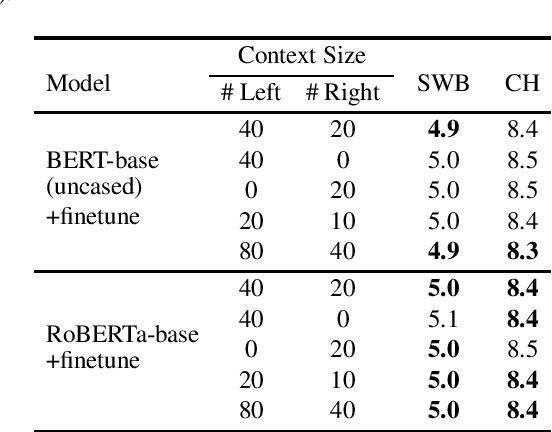
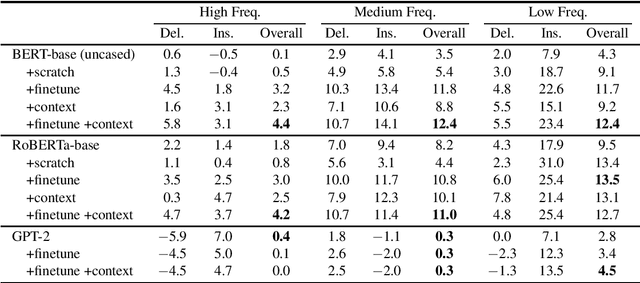
Abstract:Large-scale language models (LLMs) such as GPT-2, BERT and RoBERTa have been successfully applied to ASR N-best rescoring. However, whether or how they can benefit competitive, near state-of-the-art ASR systems remains unexplored. In this study, we incorporate LLM rescoring into one of the most competitive ASR baselines: the Conformer-Transducer model. We demonstrate that consistent improvement is achieved by the LLM's bidirectionality, pretraining, in-domain finetuning and context augmentation. Furthermore, our lexical analysis sheds light on how each of these components may be contributing to the ASR performance.
Improving Generalization of Deep Neural Network Acoustic Models with Length Perturbation and N-best Based Label Smoothing
Mar 29, 2022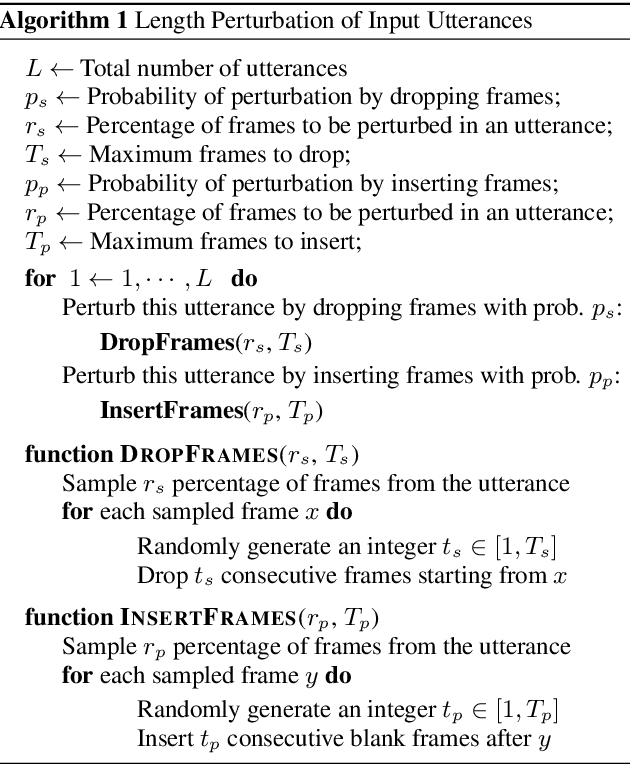
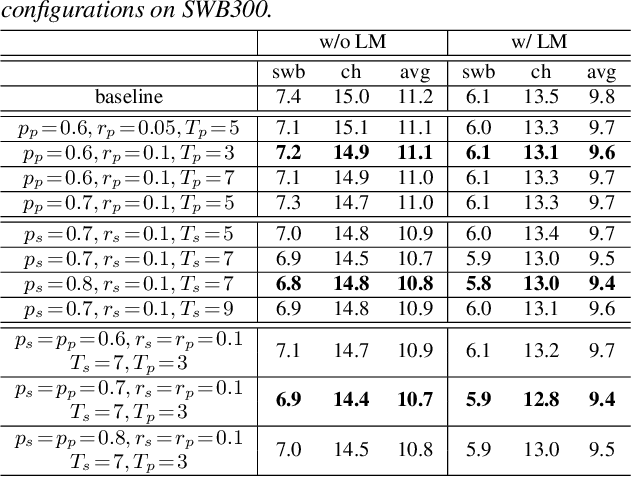
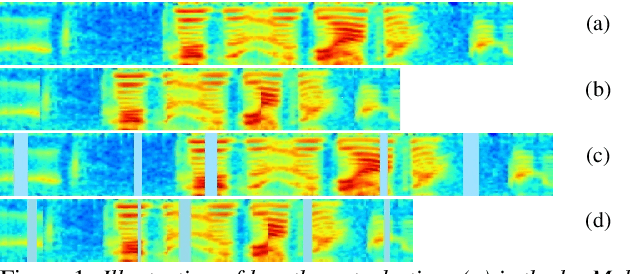

Abstract:We introduce two techniques, length perturbation and n-best based label smoothing, to improve generalization of deep neural network (DNN) acoustic models for automatic speech recognition (ASR). Length perturbation is a data augmentation algorithm that randomly drops and inserts frames of an utterance to alter the length of the speech feature sequence. N-best based label smoothing randomly injects noise to ground truth labels during training in order to avoid overfitting, where the noisy labels are generated from n-best hypotheses. We evaluate these two techniques extensively on the 300-hour Switchboard (SWB300) dataset and an in-house 500-hour Japanese (JPN500) dataset using recurrent neural network transducer (RNNT) acoustic models for ASR. We show that both techniques improve the generalization of RNNT models individually and they can also be complementary. In particular, they yield good improvements over a strong SWB300 baseline and give state-of-art performance on SWB300 using RNNT models.
English Broadcast News Speech Recognition by Humans and Machines
Apr 30, 2019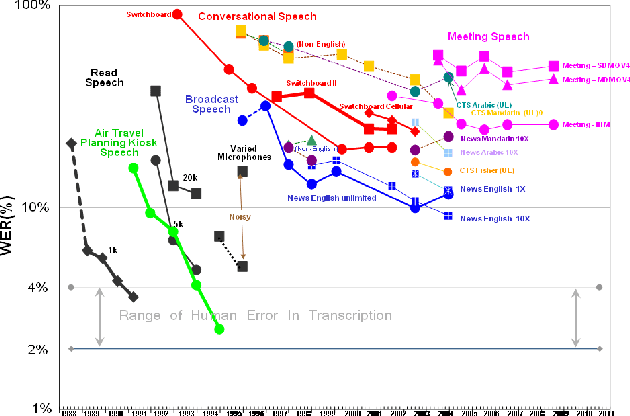

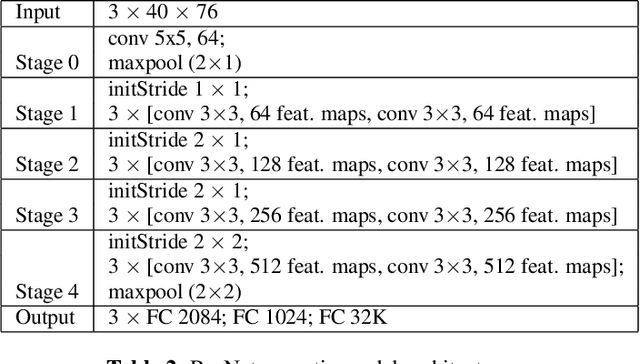

Abstract:With recent advances in deep learning, considerable attention has been given to achieving automatic speech recognition performance close to human performance on tasks like conversational telephone speech (CTS) recognition. In this paper we evaluate the usefulness of these proposed techniques on broadcast news (BN), a similar challenging task. We also perform a set of recognition measurements to understand how close the achieved automatic speech recognition results are to human performance on this task. On two publicly available BN test sets, DEV04F and RT04, our speech recognition system using LSTM and residual network based acoustic models with a combination of n-gram and neural network language models performs at 6.5% and 5.9% word error rate. By achieving new performance milestones on these test sets, our experiments show that techniques developed on other related tasks, like CTS, can be transferred to achieve similar performance. In contrast, the best measured human recognition performance on these test sets is much lower, at 3.6% and 2.8% respectively, indicating that there is still room for new techniques and improvements in this space, to reach human performance levels.
 Add to Chrome
Add to Chrome Add to Firefox
Add to Firefox Add to Edge
Add to Edge